|
|
|
Sort Order |
|
|
|
Items / Page
|
|
|
|
|
|
|
| Srl | Item |
| 1 |
ID:
163363
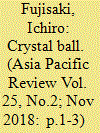

|
|
|
|
|
| Summary/Abstract |
Upon appointment as executive of Nakasone Peace Institute in the 30th year since its establishment, NPI President Ichiro Fujisaki discusses his view of the role of a research institute and outlines the aims for NPI going forward.
|
|
|
|
|
|
|
|
|
|
|
|
|
|
|
|
| 2 |
ID:
163364
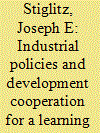

|
|
|
|
|
| Summary/Abstract |
In the countries that have been most successful in development over the past half century, government played a central role (the development state), especially through industrial policies that promoted manufacturing exports. But changes in the global economy mean that African countries won’t be able to rely on the manufacturing export-led growth model. This paper analyzes the reasons for the success of that model, and shows how the same outcomes can be achieved through a multipronged strategy, a comprehensive development plan that pays particular attention to learning and employment.
|
|
|
|
|
|
|
|
|
|
|
|
|
|
|
|
| 3 |
ID:
163374
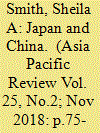

|
|
|
|
|
| Summary/Abstract |
No relationship is more important to the future of Asia than the one between Japan and China. PM Abe’s visit to Beijing last month put the relationship back on a firmer footing. Yet diplomacy alone will not stabilize Sino-Japanese relations. Popular attitudes in both countries also matter, and will be shaped by the success or failure of leaders to manage the growing complexity of this relationship from food security to fisheries management to national defense and new solutions to China’s growing influence over the daily lives of Japanese. Across Asia too, Japan and China will need to coexist without impeding each other’s influence. Next year’s visit to Japan by President Xi offers ample opportunity for expanding the foundation of this latest round of diplomatic “fresh starts” in the Japan-China relationship. Uncertainty over the US role in Asia, however, has made this a more difficult task.
|
|
|
|
|
|
|
|
|
|
|
|
|
|
|
|
| 4 |
ID:
163375
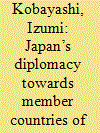

|
|
|
|
|
| Summary/Abstract |
As an island country in the Pacific region, it is natural for Japan to have diplomatic relationships with neighboring island countries. By the early 1970s, Japan started to provide Official Development Assistance (ODA) to two individual island countries in the Pacific region, and, in the mid-1980s, when most of the island countries had achieved independence, Japan’s diplomacy expanded to additional countries. In 1985 then Prime Minister Yasuhiro Nakasone made an official visit to two of the island countries, and, in 1987, official policy expressing support for the Pacific island countries’ independence, regional cooperation, political stability, economic development, and people-to-people exchange was issued. In October 1997, the “Japan-SPF Summit Meeting” with participants of leaders from Japan and 14 South Pacific Forum member island countries/regions and government representatives of Australia and New Zealand was held in Tokyo. The 8th Pacific Islands Leaders meeting held in May 2018 is symbolic of Japan’s diplomacy toward the Pacific Islands Forum member countries. This article is the author’s personal observation of Japan’s diplomacy toward Pacific Islands Forum member countries and the significance of Pacific Islands Leaders Meeting.
|
|
|
|
|
|
|
|
|
|
|
|
|
|
|
|
| 5 |
ID:
163370
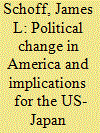

|
|
|
|
|
| Summary/Abstract |
This article examines the domestic political dynamics behind US president Donald Trump’s “America First” approach to trade and foreign policy, to understand better how long this strain of American economic nationalism might last and what it means for Japan’s national security strategy. The political base for Trump’s trade protectionism and apparent indifference to allies has roots stretching back into American history, but this movement has strengthened in recent years due to a combination of growing economic inequality in the United States, demographic changes, and the impact of fast-paced technology development and economic globalization. These political trends are likely to persist beyond Trump’s presidency, although some potential negative effects on Japan and the US-Japan alliance in the medium-to-longer term can be mitigated by Japan’s proactive foreign policy and other steps. The alliance still offers a great deal of value to both countries—now and into the future—but Japan should consider a slightly larger global leadership role in concert with others, even as the allies work to enhance their continued cooperation on shared interests.
|
|
|
|
|
|
|
|
|
|
|
|
|
|
|
|
| 6 |
ID:
163377


|
|
|
|
|
| Summary/Abstract |
In this article, the author will focus on the role former Japanese diplomat Yoshio Okawara played in the “restoration” in the context of postwar Japan–US relations, particularly in his capacity as Japan’s ambassador to the US. During the 1980s, a period when trade friction between Japan and the US was particularly intense, and diplomatic relations pluralized, Okawara emerged as a “pragmatist,” striving to vanquish the “perception gap” between the two nations. Today, the Donald J. Trump administration seems to be shaking up the global system of free trade. In the current situation, there is much to learn from the example set by the diplomat Okawara, a pragmatist who throughout his life did so much to narrow the perception gap that caused the trade frictions of the 1980s and to restore the Japan–US relationship that had been ravaged by war.
|
|
|
|
|
|
|
|
|
|
|
|
|
|
|
|
| 7 |
ID:
163376
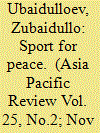

|
|
|
|
|
| Summary/Abstract |
“O Sport, You are Peace!
You forge happy bonds between the peoples
by drawing them together in reverence for strength
which is controlled, organised and self disciplined.
Through you the young of the entire world
learn to respect one another,
and thus the diversity of national traits becomes a source
of generous and peaceful emulation!”
Pierre De Coubertin (The founder of the modern Olympic Movement)
Sport is an excellent and powerful tool to promote peace, tolerance, and peaceful coexistence. Sport can bring together people of different ethnicities, nationalities, race, skin color, culture and religion. Sport promotes values, such as respect, honesty and cooperation. Sport has the power and ability to overcome the intercultural and political barriers. Sport can be the significant component of social integration. This article brings into the discussion the theme of sport for peace and a positive role of sport for international cooperation and peace. There is a limited amount of research and literature on the theme of sport and peace or sport for peace. The unique and positive power of sport for bringing about peace and peaceful solutions is not well researched and understood. Therefore, the reason for this article is to try to fill the gap in the existing literature on the theme of sport for peace and broaden the discussion about it. The article focuses on sport for peace initiatives implemented by the International Olympic Committee (IOC), the United Nations (UN) and its agencies, like UNESCO, UNICEF, UNHCR and non-governmental organizations and international sport federations. The article also examines the sport for peace initiatives from Japan, in the example of the Sport for Tomorrow (SFT) Programme of the Japanese Government for Tokyo 2020 Olympic and Paralympic Games and contribution by Japan International Cooperation Agency (JICA) in promoting and fostering friendship, cooperation, and peace in the world.
|
|
|
|
|
|
|
|
|
|
|
|
|
|
|
|
| 8 |
ID:
163372
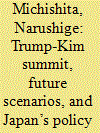

|
|
|
|
|
| Summary/Abstract |
On June 12, 2018, U.S. President Donald Trump and Democratic People’s Republic of Korea (hereafter DPRK or North Korea) leader Kim Jong Un, Chairman of the State Affairs Commission, met in Singapore for the first time. The two men signed a joint declaration and pledged to work toward denuclearizing the Korean Peninsula and improving bilateral relations. These developments raise several questions. What impact will this summit meeting between the two leaders have on regional security? What sorts of opportunities and risks will that impact produce for Japan? How should Japan deal with this fluid regional situation?
|
|
|
|
|
|
|
|
|
|
|
|
|
|
|
|
| 9 |
ID:
163366


|
|
|
|
|
| Summary/Abstract |
The United States seeks conventional military overmatch in the strategic competition with China and Russia through efforts to develop advanced technology for military application and new concept of operations as well as pursue organizational adaptation and human talent pool development. The current article will trace the development of US defense innovation efforts from the Obama administration to the Trump administration and focus on the technological dimension of defense innovation by illustrating ways through which the U.S. Department of Defense is attempting to apply “narrow” artificial intelligence for military purposes such as situational awareness, cyber, military logistics, command and control, and swarm technology and tactics for autonomous unmanned systems. The article will conclude by making two caveats regarding the actual introduction of artificial intelligence into the US battle network, and very briefly point to implications for US allies.
|
|
|
|
|
|
|
|
|
|
|
|
|
|
|
|
|
|
|
|
|